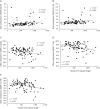DMPK gene DNA methylation levels are associated with muscular and respiratory profiles in DM1
- PMID: 31334355
- PMCID: PMC6568328
- DOI: 10.1212/NXG.0000000000000338
DMPK gene DNA methylation levels are associated with muscular and respiratory profiles in DM1
Abstract
Objective: To assess the effects of dystrophia myotonica protein kinase (DMPK) DNA methylation (DNAme) epivariation on muscular and respiratory profiles in patients with myotonic dystrophy type 1 (DM1).
Methods: Phenotypes were assessed with standardized measures. Pyrosequencing of bisulfite-treated DNA was used to quantify DNAme levels in blood from 90 patients with DM1 (adult form). Modal CTG repeat length was assessed using small-pool PCR. The presence of Acil-sensitive variant repeats was also tested.
Results: DNAme levels upstream of the CTG expansion (exon and intron 11) were correlated with modal CTG repeat length (rs = -0.224, p = 0.040; rs = -0.317, p = 0.003; and rs = -0.241, p = 0.027), whereas correlations were observed with epivariations downstream of the CTG repeats (rs = 0.227; p = 0.037). The presence of a variant repeat was associated with higher DNAme levels at multiple CpG sites (up to 10% higher; p = 0.001). Stepwise multiple linear regression modeling showed that DNAme contributed significantly and independently to explain phenotypic variability in ankle dorsiflexor (3 CpGs: p = 0.001, 0.013, and 0.001), grip (p = 0.089), and pinch (p = 0.028) strengths and in forced vital capacity (2 CpGs: p = 0.002 and 0.021) and maximal inspiratory pressure (p = 0.012).
Conclusions: In addition to the CTG repeat length, DMPK epivariations independently explain phenotypic variability in DM1 and could thus improve prognostic accuracy for patients.
Figures
References
-
- Brook JD, McCurrach ME, Harley HG, et al. . Molecular basis of myotonic dystrophy: expansion of a trinucleotide (CTG) repeat at the 3' end of a transcript encoding a protein kinase family member. Cell 1992;68:799–808. - PubMed
-
- Fu YH, Pizzuti A, Fenwick RG Jr, et al. . An unstable triplet repeat in a gene related to myotonic muscular dystrophy. Science 1992;255:1256–1258. - PubMed
-
- Mahadevan M, Tsilfidis C, Sabourin L, et al. . Myotonic dystrophy mutation: an unstable CTG repeat in the 3' untranslated region of the gene. Science 1992;255:1253–1255. - PubMed
-
- New nomenclature and DNA testing guidelines for myotonic dystrophy type 1 (DM1). The International Myotonic Dystrophy Consortium (IDMC). Neurology 2000;54:1218–1221. - PubMed
LinkOut - more resources
Full Text Sources

